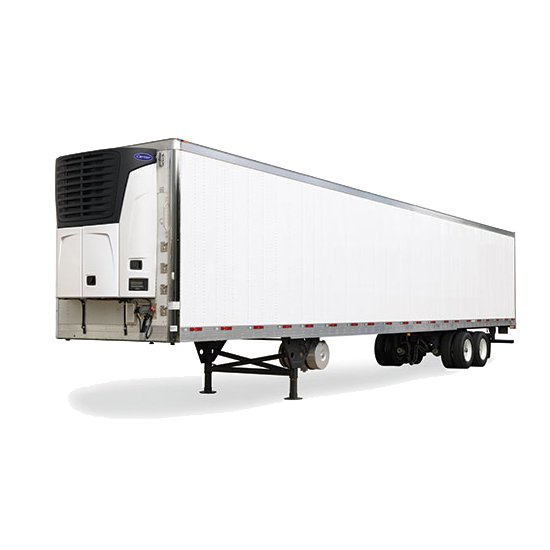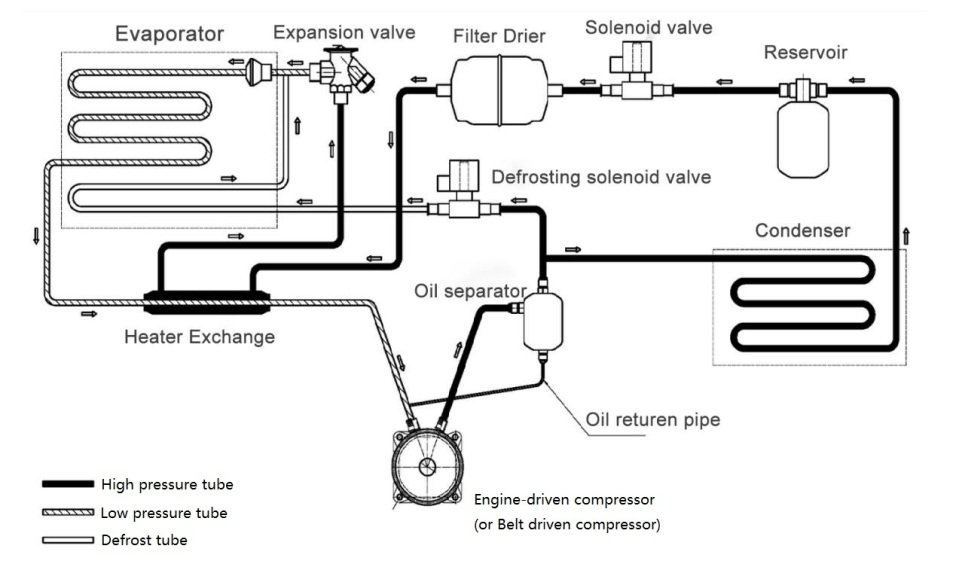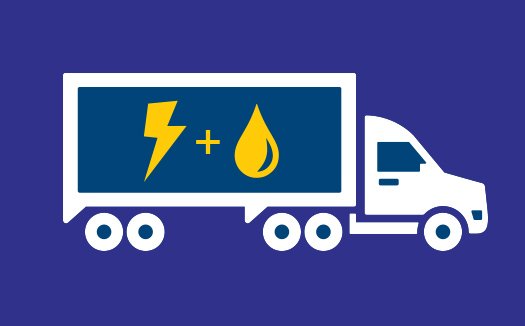Transport Refrigeration Unit

Van Refrigeration Unit

Truck Refrigeration Unit

“TRU” means transport refrigeration units. It is a medium temperature or low temperature transport refrigeration system removing heat and maintaining a steady temperature for frozen and refrigerated goods during transport or storage. It is installed on insulated vans, cargo trailers, trucks, intermodal shipping containers and rail cars. TRUs can be found in different sizes and different locations. It depends on different types of transport carrying the goods.



A conventional transport refrigeration unit uses the engine-driven compressor (also called belt driven compressor). The truck or trailer runs off the main diesel engine to drive the compressor while on road, when the truck or tailer is parked, loading, or unloading, the TRU can continue to be powered by the main engine or run off a separate standby engine. Because it use diesel duel all the time, it has direct impact on the air quality and not good for the environment.

“e TRU” stands for electric transport refrigeration unit. Nowadays, electric transport refrigeration units (e TRU) are used to replace conventional diesel powered TRUs by many people. It is including standby electric e TRU, and all-electric e TRU. In an electric transport refrigeration unit, the transport refrigeration compressor is driven by an electric motor all the time or at least part of the time. Powering the compressor with electricity offers not only environmental benefits, but also increases efficiency, and lower maintenance requirements.


The electric transport refrigeration system can operate the compressor by a plug-in electrical grid power while the engine isn’t running. The first benefit is drivers can maintain a steady temperature to keep the products cool without running the engine. Plus, the trucks are quieter; it creates a quieter environment for drive also people around.

The main benefit of an electric refrigeration system for truck reefers is more fuel saving and emission reductions. The conventional transport refrigeration units are still powered by the engine when stationary, while the electric standby transport refrigeration units are powered by a plug-in electrical grid power (also called shore power). So the electric standby TRUs reduces the carbon emissions due to the reduction of the use of the diesel fuel.

The electric standby TRUs uses the engine-driven compressor when transit, which use the transport rotary refrigeration compressor when parked. The all-electric TRUS uses the dc rotary compressor or dc scroll compressor all of the time. So it uses fewer parts and requires less maintenance than their diesel counterparts. Eliminating the use of your engine also lengthen the total life of your truck.

The electric standby transport refrigeration units are also called hybrid TRUs. It has two compressors in the refrigeration system. One is engine-driven compressor; the other is rotary refrigeration compressor. When over the road, the unit with engine-driven compressor is powered by diesel engine; when parked, loading or unloading, the electric standby unit allows the TRU to be plugged into electrical power to drive the transport rotary refrigeration compressor and the diesel engine to be turned off.
The electric standby transport refrigeration units are also called hybrid TRUs. It has two compressors in the refrigeration system. One is engine-driven compressor; the other is rotary refrigeration compressor. When over the road, the unit with engine-driven compressor is powered by diesel engine; when parked, loading or unloading, the electric standby unit allows the TRU to be plugged into electrical power to drive the transport rotary refrigeration compressor and the diesel engine to be turned off.

The standby transport refrigeration system uses two compressors; one is belt-driven compressor, the other is rotary refrigeration compressor. The transport rotary refrigeration compressor used in standby/hybrid TRU is horizontal type. The horizontal structure makes the rooftop refrigeration units low height and compact size. According to different voltage, we have 220V~240V/50HZ, 220V/60HZ, 380V/50HZ and 220V DC refrigeration compressors. The cooling capacity is ranging from 0.75HP to 3HP.
The electric transport refrigeration unit is driven by all electric, not by diesel engine. It uses electric dc compressor, for example, 12V dc compressor, 48V dc compressor, 320V dc compressor. When transit, the dc compressor is powered by onboard batteries. The batteries can be charged with rooftop solar panels as well as a generator that is built into the trailer for additional charging power. When parked, the dc compressor is powered by plugging in to grid power to fully recharge the onboard batteries.
The all-electric transport refrigeration unit uses the 12V dc compressor or 48V dc compressor or 320V dc compressor. When over the road, the all-electric transport refrigeration unit is powered by batteries directly for shorter distance; for longer distance, it is equipped with a diesel-powered TRU generator set while operating on the road.
When parked, the van engine is off, the all-electric transport refrigeration unit will not last long for refrigerating. It is better to equip with an extra transformer, which can transform the AC power to 12V dc power or 48V dc power to drive the rotary refrigeration compressor. At same time, charge the vehicle batteries.

The largest cooling capacity and highest efficiency 12 volt dc compressor. If you are looking for a large cooling capacity 12v dc air conditioner compressor, the model JFSB150Z12 is the best choice.
We will contact you within 8 hours. Please pay attention to the email with the suffix “@greehvacr.com”.